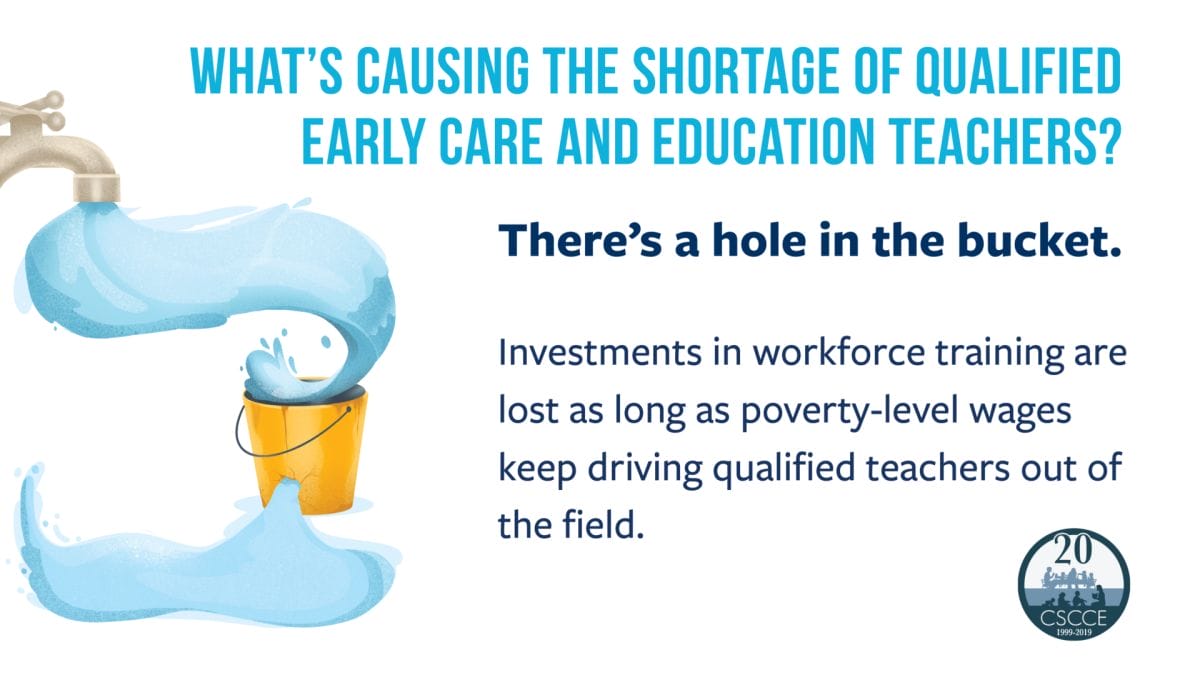Imagine your niece or nephew is headed off to college next year. They tell you that they want to work with young children because they want to have an impact on the learning process that sets kids up for success in life. They want to get a degree in early education and are particularly interested in working with infants and toddlers because they know that those are the formative years of development.
How would you react? Would you tell them that a bachelor’s degree in early care and education (ECE) is one of the lowest paying college majors? That the majority of early educators and their families have to rely on public assistance in order to get by? That even though they have an early care and education degree, they will often be called “babysitters”?
That’s the current reality for early educators in America. In 2017, national median wages for early educators ranged from $10.72 per hour (or $22,290 full-time per year) to $13.94 per hour (or $28,990 full-time per year). These are quite literally poverty-level wages: the federal poverty threshold for a family of four in 2017 was $24,600. Wages on average are even worse for early educators of color, who make up about 40 percent of the national ECE workforce, and for early educators who work with infants and toddlers.
Making early education and care an attractive field now and in the future means fundamentally reshaping early childhood jobs to provide fair compensation and reasonable working conditions. Not only will this change make a meaningful difference to the lives of current and future early educators — and therefore the children in their care — but it will be a major step forward in the valuing of historically feminine work and toward a more gender and racially just society.
Low Compensation for Early Educators Affects Us All
Low compensation for early educators is not just a problem for those who work in early care and education. It affects children now and in the future: early educators who face economic stress and inadequate working conditions have more difficulty engaging in the high-quality teacher-child interactions that matter most for facilitating children’s learning. It also affects parents and employers: poor compensation makes it more difficult to recruit and retain early educators, and without sufficient qualified early educators, there can be no reliable provision of the early education services that parents require for their own employment stability.
Anti-Poverty Strategies Are Not the Solution to Low Wages in ECE
It’s your nephew or niece again. They ignored your warnings (as young people do!) and after graduating, they’ve found a teaching job in a local early care and education center. The pay is $22,290 per year, not even a livable wage in your state, especially with the rising cost of living. Benefits are minimal and don’t include health insurance or any kind of retirement package. But their prospective employer says they can receive $2,000 in additional income as a tax credit or stipend from the state every year. But they will only qualify for this stipend after working there for a year and agreeing to stay another six months beyond that, and their center must maintain its quality rating and continue to accept public subsidies, and there are some other rules your nephew/niece can’t quite remember. You listen dumbfounded and think, “Wouldn’t it be easier to just work at Starbucks?”
It sounds crazy, right? Yet this is the most commonly proposed policy solution for early educators’ low wages. In 14 states throughout the country, initiatives offering either a supplemental stipend or a tax credit for early educators have already been implemented, typically with limited monetary levels and strict eligibility criteria.
Stipend and tax credit initiatives do provide important financial relief to educators who are struggling on poverty-level wages, but they do not improve the wages themselves and are not a long-term solution to the challenge of attracting and retaining qualified individuals to teach young children.
What Would Appropriate Compensation for Early Educators Look Like?
All those working with young children should earn at least a livable wage. Currently, however, median child care worker wages do not meet the living wage threshold for a single adult with one child in any state.
Median child care worker wages do not meet the living wage threshold for a single adult with one child in any state.
Early educators (in particular, those who lead classrooms) need specific knowledge and skills to adequately facilitate learning among a class of small children. Such training and experience should be compensated commensurate with standards for a middle-class, professional job, similar to educators of older children, in order to recognize the complexity of such work and to ensure that qualified teachers are attracted to working with children during the most important stage of their development.
Some states (such as Alabama) and several cities have been leading the way, ensuring that teachers in publicly funded pre-K classrooms are paid on par with K-3 teachers. Yet much more must be done to ensure appropriate compensation for teachers in all early care and education classrooms, regardless of the age of the child or the setting. Efforts in New York City have been moving in this direction, extending wage increases to early educators in Head Start programs and community-based centers.
“What’s in a Name?” A Glossary of Key Compensation Terms
Words like “compensation,” “parity,” and “living wage” have been gaining traction in ECE circles, but there are different interpretations of what they mean. Here’s a short guide to help bring clarity to the debate.
- Compensation: “A term used to encompass the entire range of wages and benefits, both current and deferred, that employees receive in return for their work.”
- Living Wage: Typically refers to a minimum threshold for affording basic necessities, which varies by household type and local cost of living. A living wage calculator has been developed by the Massachusetts Institute of Technology (MIT).
- Compensation Parity: The state or condition of being equal, especially regarding status or pay. In current ECE debates, it typically refers to a comparison between early educator pay and K-3 teacher pay.
- Compensation Strategy/Initiatives: Initiatives that increase workers’ base annual salaries or hourly wages and/or provide benefits such as health insurance or retirement plans.
- Financial Relief Strategy/Initiative: Initiatives that provide additional income or financial relief outside a worker’s pay and benefits (compensation), based on eligibility.
Sources: McLean, C., Whitebook, M., & Roh, E. (2019). From Unlivable Wages to Just Pay for Early Educators. Berkeley, CA: Center for the Study of Child Care Employment, University of California, Berkeley; Whitebook, M., McLean, C., Austin, L.J.E., & Edwards, B. (2018). Early Childhood Workforce Index — 2018. Berkeley, CA: Center for the Study of Child Care Employment, University of California, Berkeley.
In order to truly make progress on appropriate compensation for all early educators, there must be a reckoning with the inadequacy of current public funding for early care and education in the United States. Estimates vary on the level of public investment needed to reform early care and education, but all estimates confirm that substantial increases are necessary.
A robust public financing strategy is essential, but it is not a replacement for deliberate consideration of mechanisms to raise compensation. Though higher pay and benefits for the workforce will require additional public funding, resources alone are not a guarantee that compensation will be addressed in a sector that has been historically underfunded. Explicit minimum compensation standards — based on job role, education, and experience, rather than the age of children or type of setting — can help the system move toward more equitable, as well as adequate, compensation for early educators.
The Path Forward
“I spent most of my adult life teaching young children (three to five years old) in private international schools in various countries around the world. In those positions, I was paid a salary and benefits equal to those teaching in elementary or secondary school and given significant opportunities to pursue my own education and professional development. As a teacher of young children, I was respected and given very high status in the community. …It is virtually impossible to earn a living wage as a preschool teacher or childcare worker in America, even though parents are struggling to pay the high costs of care.”
ECE Teacher, Minnesota
It’s five years later, and you’ve just heard from your niece/nephew again. They finally got tired of barely getting by, being unable to pay off their student loans, and watching their similarly educated peers buy houses they will never be able to afford on their early educator wages. They heard of a job opportunity abroad, where early education is funded similarly to the education of older children and early educators are represented by collective agreements that ensure a livable wage. Your niece/nephew cries a little, because they didn’t want to call to say good-bye, but they are also hopeful that they will finally be able to pursue their passion of educating young children and support themselves financially, too.
Achieving a 21st-century education system in the United States requires recognizing the value of early education and rewarding early educators appropriately. This goal is not impossible. While “rights, raises, and respect” for early educators is still a work in progress, around the world some countries have demonstrated that publicly funded systems of early care and education are better able to deliver services that work for children, families, and the early educators providing the services. In the United States, the public pre-K movement, like the kindergarten movement before it, further demonstrates that it is possible to value early education and care as a public good for children and families. The voices of early educators as well as parents are crucial to continuing this process and recognizing the need for improved compensation and better working conditions for all those facilitating children’s early learning, regardless of the age of the child.
Policy Recommendations
How can we ensure that early educators like your niece/nephew are able to stay in the field and continue to teach young children, without risking their financial security now and over the course of their lives? There are several steps that local, state, and national leaders can take.
- Articulate long- and short-term goals for increasing annual earnings of early educators as distinct from financial relief and educational support.
- Establish compensation standards for starting and ongoing wages, benefits, and non-contact time for professional responsibilities, including:
- Pay scales for all teaching and auxiliary roles and education levels, using living wage/self-sufficiency standards as a minimum; and
- For lead teachers with bachelor’s degrees, regardless of setting, the compensation standard should be at least parity with K-3 teachers.
- Ensure adequate public funding is available to meet articulated compensation standards.
- Frame advocacy messages to clarify that financial relief initiatives are an interim strategy, not a long-term solution to achieve appropriate wages and benefits.
- Elevate compensation as an essential component of state workforce strategies and educate policymakers and the public at large about the importance of better pay in ensuring a skilled and stable early educator workforce.
Endnotes
- Quote from CSCCE survey of teachers. For more information about the study, see Whitebook, M., Schlieber, M., Hankey, A., Austin, L.J.E., & Philipp, G. (2018). Teachers’ Voices: Work Environment Conditions That Impact Teacher Practice and Program Quality — Minnesota. Berkeley, CA: Center for the Study of Child Care Employment, University of California, Berkeley.
Additional Resources

- What’s Causing the Shortage of Qualified ECE Teachers? There’s a Hole in the Bucket [infographic]
- The Younger the Child, the Lower the Pay for Early Educators [infographic]
- Racial Wage Gaps in Early Education Employment
- From Unlivable Wages to Just Pay for Early Educators
- Strategies in Pursuit of Pre-K Teacher Compensation Parity: Lessons From Seven States and Cities
- At the Wage Floor: Covering Homecare and Early Care and Education Workers in the New Generation of Minimum Wage Laws
- 2018 Early Childhood Workforce Index



